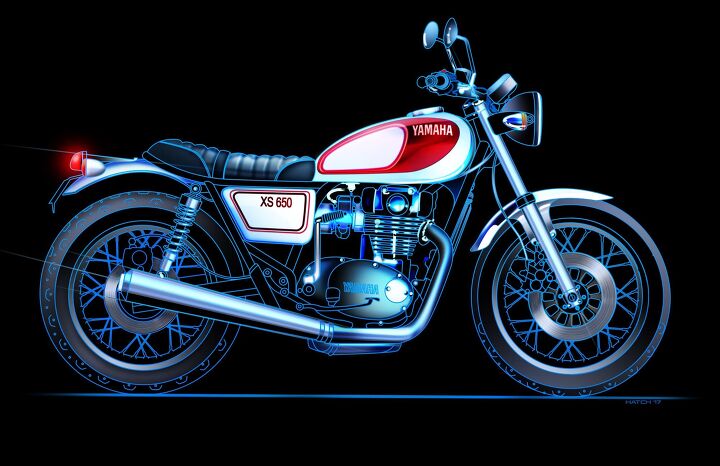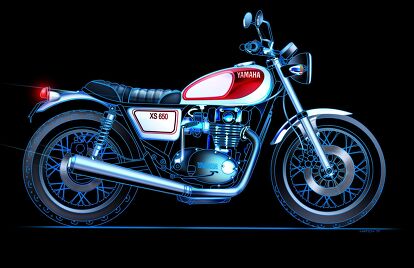2018 Yamaha XS650 Concept
Should Yamaha expand its Sport Heritage line with something like this?
Triumph is killing it with its latest Bonneville platform, churning out a variety of models that fascinate everyone from retro-minded Boomers to 20-something hipsters. Encompassing roadsters, scramblers, standards and cafe racers, the platform has huge crossover appeal to a vast swath of riders.
But Triumph isn’t the only manufacturer with a history of producing classic inline-Twins like vintage Bonnevilles. Yamaha had a 16-year run with its XS650 lineup that began in 1969, pumping out around 500,000 variants until the last one in 1985.
Like the original Triumphs, the agile XS650s used a parallel-Twin motor with a 360-degree crankshaft layout. The XS’s 654cc engine was the largest in Yamaha’s inventory until the ill-fated twin-cylinder TX750 debuted in 1973, followed in 1975 by the XS750 Triple. While the XS650 never achieved the legendary status of the Bonneville, it’s achieved a modest cult following among custom builders who want a different take on retro authenticity with Japanese reliability.
Late last year, I sat down with Shun Miyazawa, Motorcycle Project Coordinator at Yamaha, who is a key player in Yamaha’s year-old Sport Heritage line. He’s been at Yamaha Motor USA for about a year following a stint at Yamaha Motor Europe, where he was a core member for the XSR900 project. Thus far, the Sport Heritage family consists of the XSR900, SCR950, SR400, Bolt C-Spec and VMax. It’s kind of an odd mix of modern and retro, with vast performance differences.
Duke’s Den: What Is The Yamaha Sport Heritage Line?
Thus far the SH line is quite limited, so I suggested to Miyazawa that surely there must be more motorbikes on the way that will flesh out the SH family. Talking to manufacturer reps about future product is a process akin to pulling teeth except more frustrating, but still we try.
He doesn’t deny it, which I accept as a yes. But what could be next for the Sport Heritage family? To me and my sensibilities, the logical next step in would be a remake of the XS650. After all, half of Yamaha’s Sport Heritage line’s name is heritage.
“The 650 vertical-Twin is so beautiful and has got quite some character,” admitted Miyazawa-san. “People love that bike, and it’s the first four-stroke machine from Yamaha, so it’s an icon and we need to pay certain respects to it.”
Hmmm, needing to pay respects to the XS650 isn’t the same as agreeing with my suggestion of a reimagined XS650, but I continued down that path. I note the new Triumphs are relatively big and heavy, mostly because they contain engines that displace 900cc to 1200cc. Doesn’t that, I ask, leave a sizable opening in the market for Yamaha to introduce a 650cc parallel-Twin?
“I like your personal view on that,” replied the agreeable Miyazawa, “and I take it as a good suggestion.”
Well, agreeing to a loose concept idea sounds promising, so I probe with other questions. I ask if an air-cooled engine could be viable in this modern era of stricter emissions regulations.
“Technically speaking, it can be done,” Miyazawa cooly responded, noting that ultimate performance would be limited without liquid-cooling.
“The air-cooled look isn’t the only way for Yamaha to inspire younger-generation people – it’s not a must,” Miyazawa cautions. “I think today the most strict regulation could be from Europe in 2020, Euro-5 standards, and there is big talk about maybe air-cooled engines won’t be surviving that new regulation. But having obviously friends from Milwaukee, there will be a way. Nothing is impossible.
“I think having an air-cooled engine gains certain criteria,” Miyazawa continued, “starting from the look, nice vibration, mechanical feeling, being easy to customize. But there are loads of things which we or a consumer could potentially lose, starting with the weight, power efficiency… If people really love the look, there is a way to do it. But maybe at this moment it’s not hitting our vision, let’s say.”
Okay, then, if any OEM is developing a new motor, it’s more likely that it would use some sort of liquid-cooling, and if it was to be retro-themed, it would have clever arrangements of a radiator and coolant hoses that are mostly hidden from view like the latest Triumph modern classics. Keep the cylinder fins to augment cooling and to present retro visuals, also like the Triumphs. And then bore out the engine in a couple of years to bring it up to around 750cc, which could foster a performance-minded version like a cafe racer.
“Yeah, yeah, I could see that,” Miyazawa responded with a smile. So I asked if he’d like to work on a project like this.
“Yes,” he laughed, “it could be fascinating, but I’m not really allowed to say anything for the future. But I think that viewpoint has got certain sense and advantage.”
Duke’s Den: 1977 Yamaha XS750 Review (Of Sorts)
“There was a big hype a few years ago for cafe racer, and now it seems like scramblers are equally attracting, and it could also be a neutral Universal Japanese Motorcycle – UJM – which could be taken to any kind of direction,” Miyazawa observed. “We have so many choices, but it’s up to us to find the best balance between where our hearts go and where our consumer’s needs are coming across.”
Earlier in the interview, I had asked Miyazawa what the Sport Heritage line represents, and he referenced Yamaha’s Faster Sons theme.
“So those bikes had brothers in the past, but we make it faster, more affordable, reliable and all that,” he elaborated. “So let’s try to stay strong and clear homage to the bikes we had in the ‘70s and ‘80s, yet making sure in terms of weight, riding performance, components should be nearly up to date.”
So, does this mean a newly reborn XS650 is on its way? As much as I’d like to hope for it, a follow-up conversation with Yamaha led me to believe my proposed concept is akin to chasing feral geese.
After reiterating they aren’t able to comment on future models, reps simply stated they’re “excited about what the future holds for the Sport Heritage line.”
But, sadly for my concept for a reborn XS650, they did allow that they don’t have any desire to make its upcoming bikes look purely retro or engineer a retro-style motor, which effectively quashes my theory for a new platform built around a new engine.
So what do you readers think of the concept as drawn out here from my brain and digitally represented by the creative mind of moto enthusiast Jim Hatch?
Could Yamaha be successful by cribbing Triumph’s strategy with its recent Bonneville lineup but with a smaller and lighter version? Or would the relative lack of brand awareness for the old XS650 relative to the legendary Bonneville name doom a reborn XS to the dark corners of Yamaha dealerships?
As always, your comments are appreciated!
| Specifications | 1977 Yamaha XS650 | 2018 Yamaha XS650 (wishful thinking…) |
|---|---|---|
| Engine Type | SOHC parallel-Twin | SOHC parallel-Twin |
| Displacement | 653.8cc | 654cc |
| Bore x Stroke | 75mm x 74mm | 75mm x 74mm |
| Cooling | Air | Air and liquid |
| Fueling | Mikuni CV carburetor | Single throttle body |
| Horsepower (at crankshaft) | 53 at 7000 rpm | 70 at 8000 rpm |
| Torque (at crankshaft) | 39.8 lb-ft at 6000 rpm | 42 lb-ft at 5500 rpm |
| Transmission | 5-speed | 5-speed |
| Final Drive | Chain | Chain |
| Chassis | Double-cradle, steel | Double-cradle, steel |
| Front Suspension | Telescopic fork | 41mm telescopic fork |
| Rear Suspension | Twin rear shocks | Twin rear shocks |
| Front Brakes | 267mm discs, dual opposed-piston calipers | 310mm disc, four-piston caliper |
| Rear Brake | Single leading-shoe drum | 270mm disc, two-piston caliper |
| Front Tire | 3.25 x 19 | 100/90-18 |
| Rear Tires | 4.0 x 18 | 150/70-170 |
| Rake/Trail | 27º/4.47 inches | 25.0°/4.3 inches |
| Wheelbase | 56.5 inches | 56.0 inches |
| Seat Height | 31.9 inches | 30.5 inches |
| Fuel Capacity | 4.0 gallons | 4.0 gallons |
| Dry Weight | 421 lbs. | 405 lbs. |
| Wet Weight | 478 lbs. | 430 lbs. |
| Top Speed | 115 mph | 130 mph |
More by Kevin Duke



































Comments
Join the conversation
If they did a retro XS650, 1981-1985 styling, with a center stand and maybe a good old fashioned kick starter, then I would literally buy two...and I am not joking!
It's a shame they don't build a XS650 or XS800? Already looks great as a long tracker 🤔 but I think someone should just build Refurbished ones in a lighter frame and better brakes, kept the tank and seat from XS1